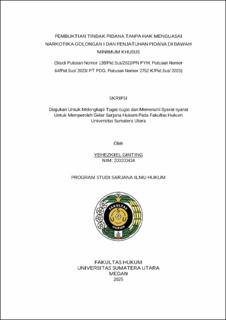| dc.contributor.advisor | Yunara, Edi | |
| dc.contributor.advisor | Lubis, Rafiqoh | |
| dc.contributor.author | Ginting, Yehezkiel | |
| dc.date.accessioned | 2025-04-24T01:15:27Z | |
| dc.date.available | 2025-04-24T01:15:27Z | |
| dc.date.issued | 2025 | |
| dc.identifier.uri | https://repositori.usu.ac.id/handle/123456789/103355 | |
| dc.description.abstract | This research is based on law enforcement against perpetrators of narcotics abuse after the issuance of Supreme Court Circular Letter Number 03 of 2015, which regulates criminal impositions under special minimum criminal sanctions, with a study of the Decision of the Supreme Court of the Republic of Indonesia Number: 2752 K/Pid.Sus/ 2023. Based on this background, the main problem in this research is how to regulate the scope of narcotics crimes and formulate the threat of sanctions? How is the sentence imposed under the special minimum threat for narcotics crimes? What are the judge's considerations in proving a criminal act without the right to control class I narcotics and imposing a crime under a special minimum threat in Decision Number 138/Pid.Sus/2022/PN PYH, Decision Number 64/Pid.Sus/ 2023/ PT PDG, Decision Number 2752 K/Pid.Sus/2023? This research uses normative legal research methods. The collected legal material secondary, The data sources used include primary, secondary and tertiary data. are then analyzed deductively to draw conclusions from the legal events being researched. The results of the research show that the regulation of the formulation of threats of sanctions for narcotics crimes in Indonesia is regulated in Law no. 35 of 2009. There are 2 (two) types of criminal sanctions formulation systems. The first formulation system is the maximum system. Second is a system for formulating the length of criminal sanctions by determining the minimum and maximum limits of criminal threats. Although legal regulations regulate minimum criminal penalties as a form of protection and prevention against drug trafficking, there are certain circumstances where the court can impose a sentence below the minimum threat. This can happen by considering the legal facts and the weight of the evidence presented at the trial with reference to SEMA Number 3 of 2015. Analysis of the evidence for criminal acts without the right to control class 1 narcotics and the imposition of a crime under a special minimum threat, is linked to the considerations of the panel of judges Number 2752 K/Pid.Sus/2023, if the implementation of SEMA Number 3 of 2015 is linked to the facts of the trial, then the Supreme Court Decision Number 2752 K/Pid.Sus/2023, is appropriate and correct so that the judge decides according to the indictment but can deviate from the special minimum criminal provisions by making sufficient considerations. However, the application of sanctions under the threat of special minimum criminal sanctions is considered to be contrary to legal certainty which is the main demand in law. It is recommended that state administrators as makers of legislative regulations immediately make changes to Law Number 35 of 2009, namely by creating a policy formulation concept regarding limits on the weight/value of narcotics along with criminal threats so that it will not cause confusion and no legal certainty for justice seekers, both criminal prosecutors and law enforcers. | en_US |
| dc.language.iso | id | en_US |
| dc.publisher | Universitas Sumatera Utara | en_US |
| dc.subject | Evidence | en_US |
| dc.subject | Narcotics | en_US |
| dc.subject | Special Minimum Penalty | en_US |
| dc.title | Pembuktian Tindak Pidana Tanpa Hak Menguasai Narkotika Golongan I Dan Penjatuhan Pidana Di Bawah Minimum Khusus (Studi Putusan Nomor 138/Pid.Sus/2022/PN PYH, Putusan Nomor 64/Pid.Sus/ 2023/ PT PDG, Putusan Nomor 2752 K/Pid.Sus/ 2023) | en_US |
| dc.title.alternative | Proof of the Crime of Illicit Possession of Narcotics Category I and the Imposition of Punishment Below the Special Minimum (Study of Decision Number 138/Pid.Sus/2022/PN PYH, Decision Number 64/Pid.Sus/2023/PT PDG, Decision Number 2752 K/Pid.Sus/2023) | en_US |
| dc.type | Thesis | en_US |
| dc.identifier.nim | NIM200200434 | |
| dc.identifier.nidn | NIDN0022126005 | |
| dc.identifier.nidn | NIDN0025077403 | |
| dc.identifier.kodeprodi | KODEPRODI74201#Ilmu Hukum | |
| dc.description.pages | 118 Pages | en_US |
| dc.description.type | Skripsi Sarjana | en_US |
| dc.subject.sdgs | SDGs 16. Peace, Justice And Strong Institutions | en_US |


